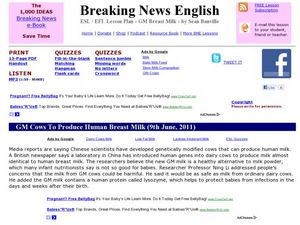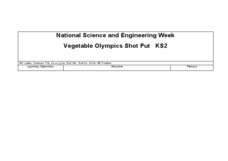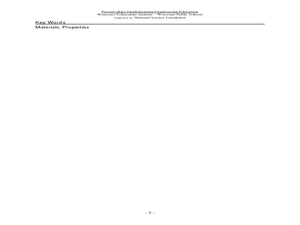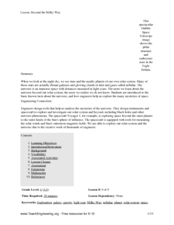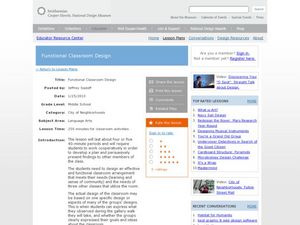Curated OER
Breaking News: GM Cows to Produce Human Breast Milk
Students explore current events by reading and analyzing an article in class. In this human diet lesson, students read an article about cows which are being genetically modified in order to produce human breast milk for consumption....
Curated OER
Vegetable Olympics Shot Put
Students explore the distribution of plant seeds. In this science lesson plan, students discuss plants that explode in order to spread their seeds. Students create pea shooters and use dried peas to see how far they will travel.
Curated OER
What Does a Philanthropic Organization Do?
Students explore the work of a local nonprofit organization and define "nonprofit" and "profit" organizations. They identify examples of three local philanthropic organizations and work together to draw conclusions about a non-profit...
Curated OER
Diplomacy, Humor Take New NHTSA Chief Far
Students explore traffic safety. In this National Highway Traffic Safety Administration lesson, students read the USA Today article titled "Diplomacy, Humor Take New NHTSA Chief Far," respond to discussion questions regarding the...
Curated OER
Introduction to Materials: Properties of Materials
Pupils explore the properties of matter. In this properties of materials lesson plan, students examine wood, metal, rubber, Styrofoam, and plastic. Pupils identify the attributes of each of the materials.
Curated OER
A Healthy Old Age?
Students explore the role of the National Health Service (NHS) in Britain. In this current events lesson plan, students visit websites and listen to lectures to learn about Britain's free health care. Students investigate...
Curated OER
Digging for Knowledge
Young scholars explore coal mining in Great Britain. In this mining instructional activity, students visit selected museums and learning centers online and in person to study mining processes, the history of mining,...
Curated OER
Thinking Like a Scientist
Students explore the scientific method. Students identify the steps in the scientific method and explain what each step means. Students use these steps to determine if boys or girls are taller in their classroom.
Curated OER
What is April Fool's Day?
Students explore humor by creating their own practical joke. In this April Fool's Day instructional activity, students read different situations in which practical jokes were taken too far. Students discuss their reactions to the jokes...
iCivics
DBQuest: The Nashville Sit-In Movement
What was it like to be a part of the sit-ins during the Civil Rights Movement? Learners consider the question and whether the protests were effective using an online documents-based investigation. The program allows for virtual...
Will Steger Foundation
The Carbon Cycle - What are its Implications for Climate Policy?
The carbon cycle isn't a bike which produces carbon and this lesson explains why. Through reading and discussion, groups of pupils create visual explanations of the four parts of the carbon dioxide oxygen cycle. Activities...
Oleh Yudin
iCrosss
Did you know that a soccer ball is very similar to a truncated icosahedron? Both have 32 faces, but while a truncated icosahedron is made up solely of flat hexagons, a traditional soccer ball has 12 pentagons and 20 hexagons, each curved...
Curated OER
Ooblek
Students demonstrate the three states of matter. In this matter lesson, students read Bartholomew and the Ooblek. Students create "ooblek" and discuss what state of matter it is.
Curated OER
The Little Transistor That Could
Students explore the nature of technology through the history of the transistor. They examine how the engineers at the Bell Labs used knowledge of science and technology, together with strategies of design, to solve practical problems.
Curated OER
Catch Up On Tomato Technology
Students explore the ways in which technological advances have benefited tomatoes as a commodity. In a small group, students review information related to the selective breeding and genetic engineering of tomatoes. Groups compose a...
Curated OER
Peanut Butter Broccoli
Students explore selective breeding and genetic engineering. They illustrate that produce items have a wide variety of traits that can potentially be combined to produce a new food by creating a class graph.
Curated OER
A Simple Machines Activity
Fourth graders observe examples of simple machines found in the school, playground, and work environment. In this simple machines instructional activity, 4th graders review simple machines by viewing three web sites. Students tour the...
Curated OER
Surveying: 19 Chains and 50 Links
Through an interdisciplinary lesson, emerging engineers explore the history of surveying systems. After discussing various systems, they perform surveys on printable pages. Using their geometric skills, they physically stake out plots...
Curated OER
Beyond the Milky Way
Fourth graders explore space science. In this space exploration lesson, 4th graders investigate the tools that engineers use to examine the solar system. Students analyze the history of the stud of the solar system.
Curated OER
Functional Classroom Design
Students work in groups to design an effective and functional classroom. In this classroom design lesson, students discuss community and make a mental map and sketch of their classroom. Students complete a handout about the design...
Curated OER
Potential and Kinetic Energy
Sixth graders explore potential and kinetic energy. In this science lesson, 6th graders assume the role of a roller coaster engineer and design a roller coaster. Students use their knowledge of kinetic and potential energy to design a...
Curated OER
Techno Hero
First graders explore digital communication by creating a slide-show presentation. In this PowerPoint presentation lesson plan, 1st graders research a famous hero using search engines and other Internet tools. Students create a...
Curated OER
Industrial Processes of Polymers: How Toys Are Made
Students explore the industrial engineering process used to make everyday materials. In this chemistry and environmental lesson plan, students learn about how different materials are made and learn about different types of polymers used...
Curated OER
Robots
Students explore the two kinds of fluids: liquids and gases. They explain that liquids (water), unlike gases (air), cannot be compressed. This property makes them ideal for hydraulic work applications.
